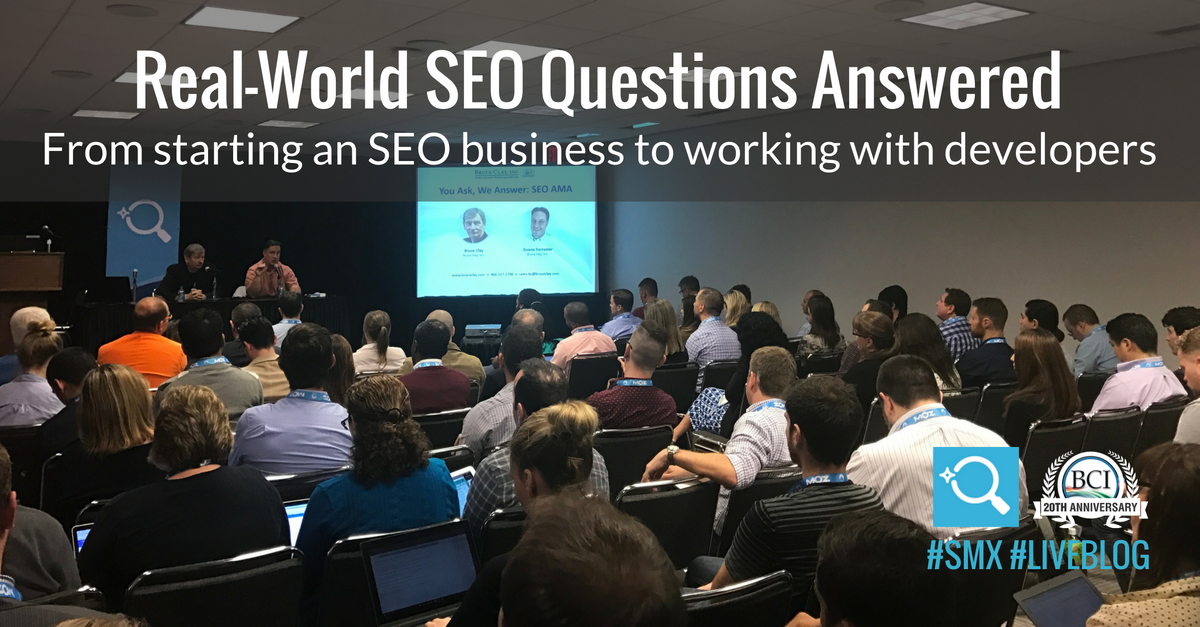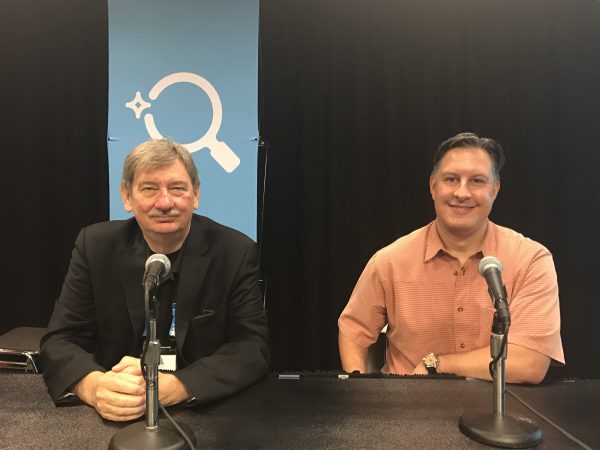SEO Godfather Bruce Clay & Search Insider Duane Forrester Field Digital Marketers’ Questions at #SMX
This is a report from SMX East 2016. Search Marketing Expo (SMX) features speakers from industry-leading digital marketers and search engine representatives. Subscribe to the BCI Blog to get coverage of key sessions sent to your inbox.

Representing Bruce Clay, Inc., Bruce Clay and Duane Forrester hosted an AMA (ask me anything) session at SMX East 2016. The audience is packed and ready to dive into hot SEO topics including:
- Starting an SEO business
- Reviews as ranking factors
- Inorganic link clean-up
- Redirects in light of link penalties
- Communicating SEO priorities to developers
- Moving to HTTPS
Where do we start with SEO and how do we get the most out of our site as a garage-based business? What’s a good blueprint for the next six months?
Bruce: If you haven’t taken a formal course, I’d recommend it. Read books, pay attention, go to conferences – invest your time and money in understanding SEO. Don’t violate any rules, write content that is worthy of being linked to and then let people know you created it.
Are reviews ranking factors?
Duane: Reviews are about a trust-level factor. Mentions indicate sentiment at a consumer level. Google and Bing will not look past that.
Reviews are good and extraordinarily powerful. Millennials and Generation Z have a huge impact on consumer spending and on businesses, so it’s very important to understand what matters to them.
You want to hear from them and know what they think is good and bad. Millennials and Generation Z trust anonymous grouped results more than friends and family.
Generation Z is still figuring out what matters to them. They have no brand loyalty.
Do not auto-generate reviews. Absolutely not. If you were our client and you did that, we would fire you. That will destroy your domain and your SEO career.
Bruce: It’s all about trust. The Google Quality Rating Guidelines talks about expertness, authority and trust. These are the three most important things they look at when determining how a site should rank. (Learn more about the Google Quality Rating Guidelines.) There’s actually a fourth factor, too: maintenance.

How do you deal with spammy links. Getting spammy links every month. What is the best practice to clean up?
Bruce: We have a free guide to link pruning that gives you the complete how-to procedure.
TL;DR: Identify the bad links with Majestic, sort by lowest trust, add them to a disavow file. (Do a free check of your backlinks against backlinks others have disavowed at DisavowFiles.com.)
There are four terms worth understanding: organic, inorganic, transactional and navigational.
Organic links should be experts in my field and the link should support my business. Suppose I’m an SEO company and you link to me but you have a site about cowboy boots, Google won’t count that. Organic is subject-related.
Inorganic is when they’re not related and those will not be counted by Google. Google gives them no weight.
Then there’s transactional and navigational. Transactional is when you’re linked to with a keyword. If 80 percent of your inbound links are transactional, Google will see you as a spammer. Navigational is anchor text like “click here.”
Duane: We like to think of this in terms of bad actors. If a dentist links to me, that is irrelevant to me – I’m not associated with the world of dentistry. It’s not just about spam – it’s about cleaning up irrelevant links.
We have multiple sites, two of which sell similar offerings. Do you have any ideas on how to market one of them that’s newer without cannibalizing the established brand?
Duane: You need to take one of those horses into the backyard and let it go. The best way forward is to determine which one should live and migrate (301 redirect) the other. Focus on the stronger site and move forward.
Bruce: If your content is replicated, use canonical tags. I would at least consolidate links and PageRank. If you have multiple instances on multiple domains of the same source, Google will consider it spun content and it won’t benefit you on either site.
We changed domain names and 301 redirected our old site to our new site. Where do I check for bad links?
Bruce: Both sites. If a domain had a penalty and it was totally trashed, what you redirected it to will inherit the penalty. Analyze and purge both.
How important are things like heading tags, image names and alt tags in terms of ranking factors? If they are important, how do I convince my designers and developers to use those things correctly?
Duane: All these things are a fundamental piece of the work you need to do. If you don’t do it and your competitor does, your competitor will be shown ahead of you. If everything else is equal, they’re just a little more useful than you.
Bruce: According to the Americans with Disabilities Act, you must have an alt attribute. (Learn more about image optimization and alt attributes in Point 11 of our SEO Checklist). Also, a designer who uses a heading tag to format something is lazy.
Can you disavow an entire domain?
Bruce: Yes, but not a TLD.
Do you consider m-dot site for ecommerce?
Duane: No.
At what point do you make the jump to HTTPS?
Bruce: Now. Make it your initial 301. Spammers with 50,000 websites are not going to pay for those certificates. This is the cost of organic ranking.
I believe Google’s plan is to give a boost to HTTPS in the future. Officially, it’s just a tie breaker. But understand that Google is going to evolve to where HTTPS is going to be a requirement for top rankings.
Why do some exact match domains still rank well?
Bruce: I would assume they’re also legacy domains that have been around for quite a few years.
| Bruce Clay, Inc. is a global digital marketing agency specializing in SEO services, SEM PPC, content development and social media marketing. Looking for a partner to grow your online business presence? Let’s talk. |

2 Replies to “SEO Godfather Bruce Clay & Search Insider Duane Forrester Field Digital Marketers’ Questions at #SMX”
Always amazed to read your post. I must say you guys really provide the updated and fresh content. Thanks for sharing :)
I would have not thought about using canonical tags to differentiate product lines on different websites. It is good that Google is focusing on quality and trust, otherwise it just gets down to who can game the rankings the best. What the end user wants at the end of the day is to get the information they are seeking and it is of great quality.
LEAVE A REPLY









